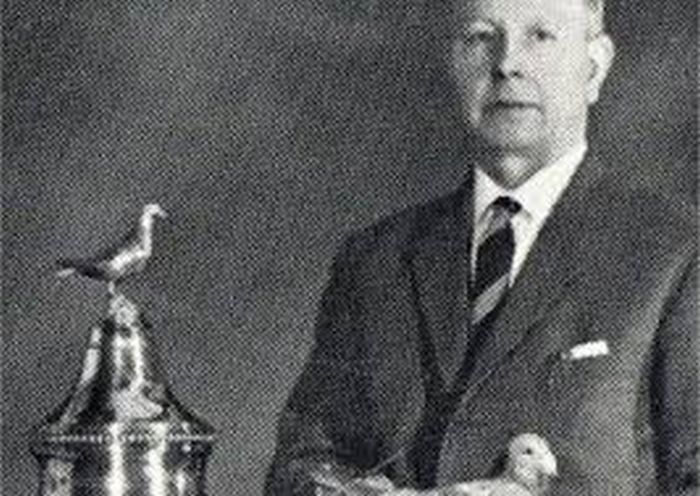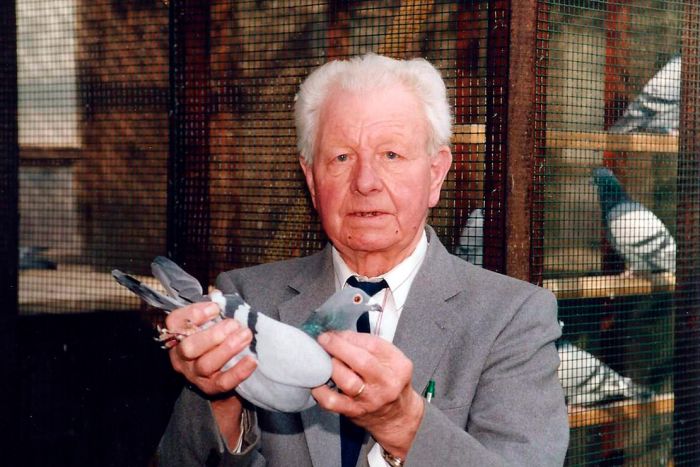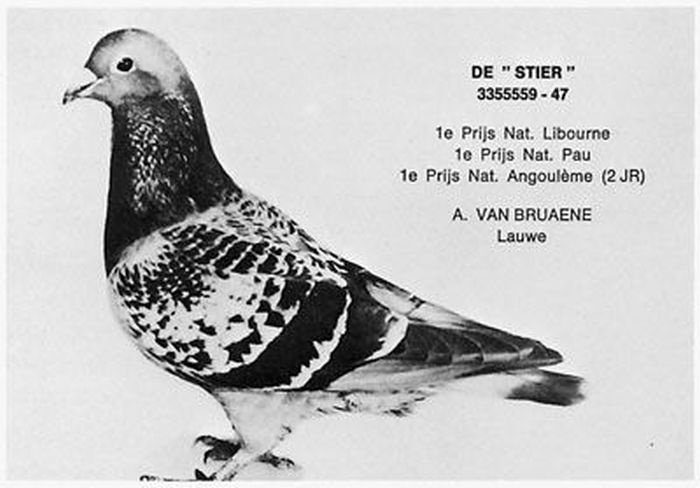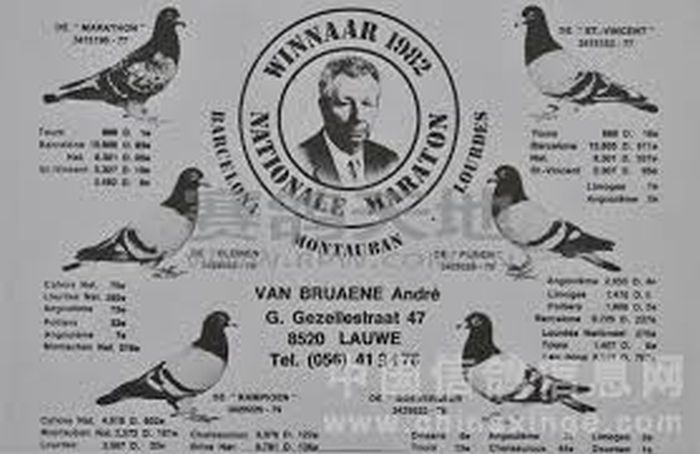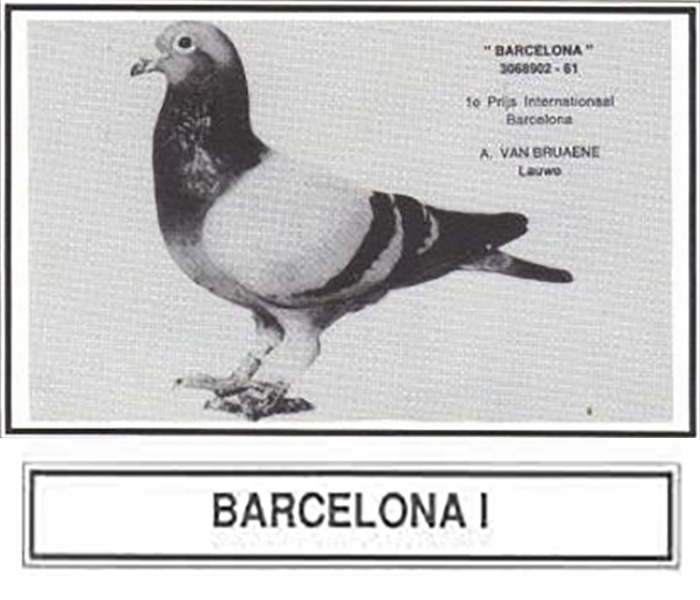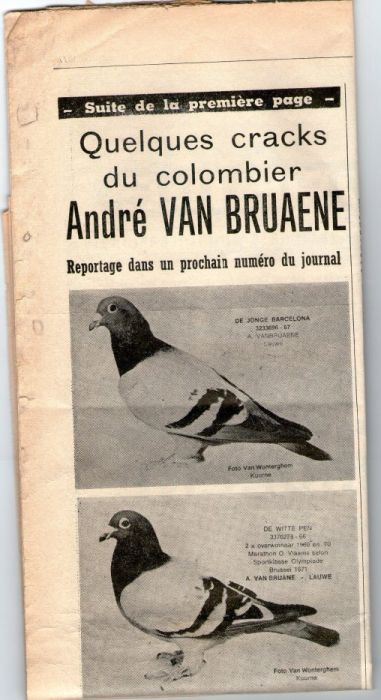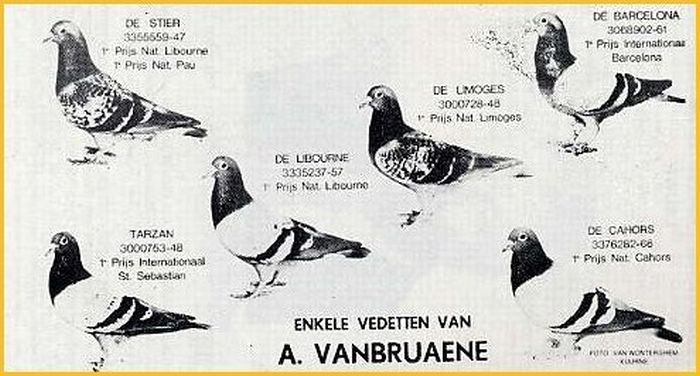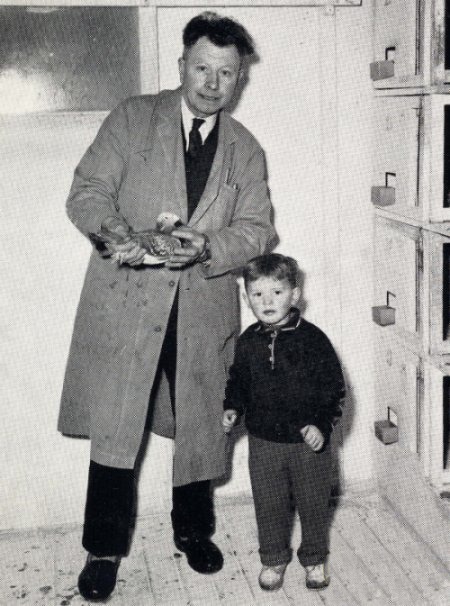André Vanbruaene
André Vanbruaene, Master Breeder and Racer, born in 1910 in Lauwe, Belgium.
- Steve O'Dea
- March 25, 2021
- 9:34 am
Watch, Listen or Read about André Vanbruaene Racing Pigeons below here....
 “…In his later life Andre recounted one instance when his uncle brought him a young blue cock not yet moulted, that had, as he said, “walked” into his loft. “You have to use him Andre. It is definitely a pigeon from very good blood”
“…In his later life Andre recounted one instance when his uncle brought him a young blue cock not yet moulted, that had, as he said, “walked” into his loft. “You have to use him Andre. It is definitely a pigeon from very good blood”
André Vanbruaene, better known as ‘Mister Barcelona’ was born on April 4th in 1910. He died on March the 8th in 1999. He is the man that made the town Lauwe in West-Flanders famous in the world of pigeon racing. Born into a farming family, Andre Vanbruaene was familiar with hard work. His family grew flax, a key constituent in the production of linen, on their farm in the region of Heusden near Ghent. Andre learned the trade and the family prospered as yields and demand were high in mid1920’s Europe.
In 1925 homesickness led to the family returning to their homeland in the region of Leie, and they quickly resettled back into familiar surroundings. Although Vanbruaene’s parents had prospered, it was Andre’s paternal uncle who was the businessman in the family. Uncle Gerome Vanbruaene, recognised that the prosperity given from the flax would be short-lived, as world trends were going away from natural fabrics. He persuaded Andre’s parents to let him take young Andre under his wing and train him in the furniture business.
His uncle Gerome also happened to be one of the most successful pigeon fanciers of the region. Living on the farm during the week Andre travelled to his uncles at the weekend. It was on these trips that he spent his pigeon apprenticeship. His uncle knew everyone important and successful in pigeons and young Andre was eager to learn at the feet of these masters. On bicycle, his uncle and he would visit the likes of Benoot in Olsene, Lagas in Ingelmunster. Vadecaveye in Wingene Vereecke in Deerlijk and many more. Despite his father’s protestations Andre fitted traps in the roof of the family’s barns and proceeded to accumulate the best birds that his uncle possessed. His uncle was a very impatient man with his birds, even if a bird had won the week before, if it failed the following week he disposed of it and this is how Andre at 17 had acquired some of the best birds in the area.
In his later life Andre recounted one instance when his uncle brought him a young blue cock not yet moulted, that had, as he said, “walked” into his loft. “You have to use him Andre. It is definitely a pigeon from very good blood” his uncle showed him the bird and on its wing was stamped the name Deprez form Etimpuis. A friend of his uncle.
On hearing the name Deprez, another top local fancier of the area, Louis Slosse, insisted that Gerome give him the bird instead of a mere youth. The reason being that Deprez was the son in law of the famous Julien Commine, from Leers-Nord. Andre didn’t particularly like the bird but upon seeing the reaction of Slosse, he bred from it and its children had immediate success.
André was only 17 years young when he started winning pigeon racing on the sprint races. Unfortunately, his natural flair for everything about pigeon racing and the quality of birds provided by his uncle brought him too much success too quickly for the liking of many of his older competitors and he quickly found himself excluded in some clubs because he won too many prizes and championships at such a tender age.
 “…From this pigeon he bred the strain of the Old Stier from 1932. He raced like a Bull from Clermont and yes, that’s how he got the nickname: De Stier from Lauwe.”
“…From this pigeon he bred the strain of the Old Stier from 1932. He raced like a Bull from Clermont and yes, that’s how he got the nickname: De Stier from Lauwe.”
This made him decide to enter in the long distance racing, the national races. I casually said to my Uncle: If you want that blue pigeon back, then you’re welcome to it. I wasn’t in love with the pigeon at the time, says André, and yes, how things sometimes turn out. Well, my Uncle gave the pigeon to a young fancier from Kuurne called Germain Desplenter. He raced fantastically with youngsters from this pigeon. Uncle Gerome upon seeing these results eventually woke up and the pigeon returned.
From this pigeon he bred the strain of the Old Stier from 1932. He raced like a Bull from Clermont and yes, that’s how he got the nickname: De Stier from Lauwe. This pigeon also won a first from Orleans and Tours. These early successes meant that Andre soon came into contact with the Cattrysse brothers, with Dupont from Herseeuw and with many other fanciers at the top at the time. They often sat together in the pubs by the pigeon societies. They told each about of their experiences and Andre listened to all these serious discussions like an upcoming star.
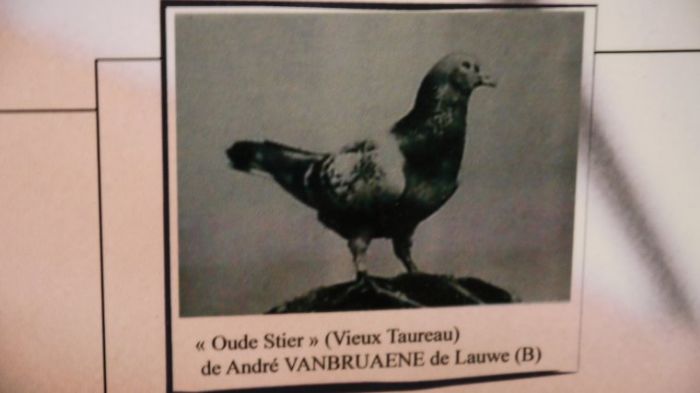
During his early days of national racing he travelled around in the only car in West-Flanders, it was from Reimy Molein from Lepur. He was rubbing shoulders with many wealthy fanciers, all the while having to fund everything from his pocket money. Unlike modern generations he kept quiet and listened, always wanting to hear what he could use to make his birds and himself better.
He recalled that on one occasion he was trying to buy a bird from the Cattrysse brothers, “It took me seven months before I could get hold of the pigeon and then only with the intervention of Ernest Derumeaux, a friend of the Cattrysse. At the time the Cattrysses had been having terrible problems with pylon wires, losing many good birds to them.
He had gone upstairs to the loft to look at the birds and saw a bird on the landing board with the tell-tale sign of a wing hanging down an obvious victim of the wires. Gerard Cattryse said to Gerome Vanbruaen ; look at that pigeon sitting there it is a brother of our Louis. (Louis being the best Cattrysse bird of that time). Andre pretended not to understand what was being said. Later when Oscar Cattrysse the family patriarch came into the loft Andre asked him about the injured bird how much for it, not wanting to let on how good the bird was, Oscar just said “that’s not a pigeon, it’s rubbish” – 7 month’s later the bird was eventually in the Vanbruaene loft.
At one point Andre met M. Julien Commine, who came to basket his pigeons. He recalls the meeting and the history of the blue cock given to him by his uncle, “Hewel, Vanbruaene, young fancier, is how he addressed me. With which pedigree do you play the big drum here? I hardly dared tell him. I said, mister Commine, don’t be angry. And then I told him the events as they happened. Do you have the pigeon, he asked me, do you have it in your loft? Hewel, he said, there is no better sort for breeding. That is a son from my Napoléon with one of the very best breeding hens from Paul Lamote from Moeskroen. Now, it is important that you should know that Paul Lamote was the leader in the pigeon sport at the time. You couldn’t have a better pigeon, said Commine. That is the best pigeon racing at the moment. Look, he said ‘You can keep it, it’s in good hands. But, when it suits you, you have to breed a couple of youngsters out of it for me.
The success he had with him however was cut short, and unfortunately Vanbruaene was never able to breed those youngsters for M. Commine as the second world war broke out. Keeping his birds throughout the war was a struggle, they were no longer prized racers but potential sources of food for an increasingly hungry nation. During this period, he was fortunate to have an ally – Dr. Coene, who as well as being a medical doctor, was also a very keen pigeon fancier and was able to assist in keeping the Vanbruaene colony safer than many of his compatriots birds that were deported to Germany. After the war while many others had to start again Vanbruaene still had many of his birds to breed from.
 “…“Andre my pigeon was lucky to come home along with your Stier, the Stier however went after a good looking hen and my bird came straight into the loft. So in fact Vanbruaene, it was because of a pretty lady that meant you were beaten” ”
“…“Andre my pigeon was lucky to come home along with your Stier, the Stier however went after a good looking hen and my bird came straight into the loft. So in fact Vanbruaene, it was because of a pretty lady that meant you were beaten” ”
The Vanbruaene strain is bred from the inbreeding of the lines, Cattrysse, Remy Buysse, Stichelbout, Willequet brothers, Labeeuw, professor Vangrembergen and De Baere. The best pigeons from West-Flanders brought together in the strain of Vanbruaene. The entire history of Vanbruaenes success from Barcelona has its origin with the Zwarte Chateauroux from Daniel Labeeuw. He won 1st National when Vanbruaene won 2nd national with the Stier. Vanbruaene recounts the story after the race when Labeeuw said to him
“Andre my pigeon was lucky to come home along with your Stier, the Stier however went after a good looking hen and my bird came straight into the loft. So in fact Vanbruaene, it was because of a pretty lady that meant you were beaten”
So it was decided between friends that the Zwarten would be mated with a daughter of the Stier. Out of the two eggs that Vanbruaene got, he hatched 2 black pigeons, a cock and a hen. The cock was paired back into his own stock and produced Barcelona I in 1961. Then came the biggest mistake Vanbruaene believes he made in all his time keeping pigeons. He decided to sell Barcelona I to Japan. Luckily he was able to stall the Japanese man and let him quickly fertilise a few hens which gave him “ Elektriek” and the hens from which all his good pigeons now come.
Elektriek was a formidable pigeon, son of 1st International Barcelona, and an excellent breeder. And that doesn’t happen that often. A good pigeon which also becomes an extra breeding pigeon. They don’t all breed well. was a great exception. Nearly all Vanbruaenes stock comes down from him with continual successes, at Vanbruaenes and in other lofts, around the world. It was the cock ‘Vechter 3429141/79’ who won 1st international Barcelona for André for the second time. He won against 13.033 pigeons. This cock was called ‘Barcelona II’ after the victory. He was a grandson of ‘Electriek’ and had some blood from prof. Vangrembergen.
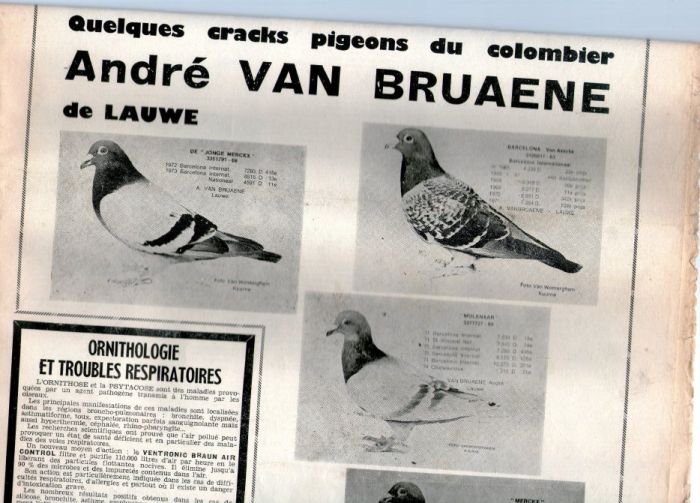
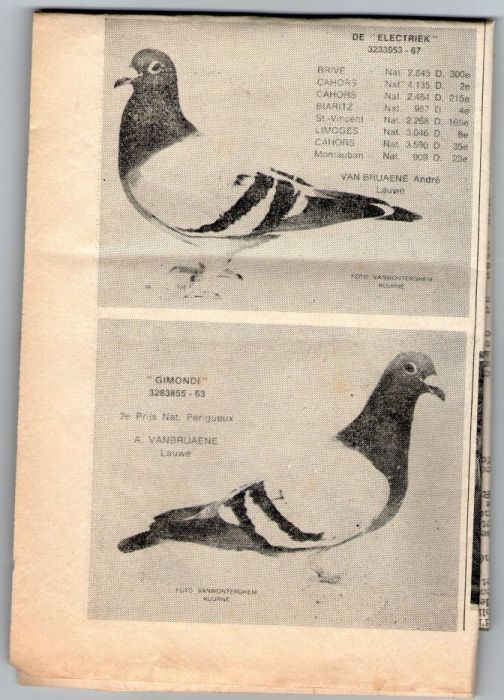
Elektriek bloodline produced 4 international Barcelona winners: Gilmont in 1983, Vanbruaene in 1984, Vervisch in 1985 and Gyselbrecht family in 1995. The blood of ‘Electriek’ produced winners all over the world: 1st national Perpignan 1988 and 1st national St-Vincent 2002 at the loft Ivo Vanlerberghe, 1st national Pau England 1982…..too many to publish.
In 1952 he owned the cock ‘Tarzan’ which flew from Spain to Belgium in one day. This was an amazing performance. He won the international race San Sebastian with this effort. .
André Vanbruaene was sometimes called The Toreador From Lauwe and was a relentless competitor at the distance races. He won the national Marathon averages prize of Belgium / Holland in 1982 and 1986. He amazed the whole world in 1987 at Barcelona. The race in 1987 was raced in strong, hot weather. The best weather for the Vanbruaene birds. André clocked his 8th bird on the 1,847 prize international. He only had 8 birds in race! Most fanciers did not have one bird at home, André had 8/8. André clocked 10/10 a few years later on Barcelona. He owned birds that are born to race Barcelona. André became sick in 1991 and participated for the last time in the Barcelona race. He won 20th and 91st international then ! What a way to end a career. His grandsons Pascal and Patrick started with his pigeons and he retired.
 “…André Vanbruaene was sometimes called The Toreador From Lauwe and was a relentless competitor at the distance races. He won the national Marathon averages prize of Belgium / Holland in 1982 and 1986. He amazed the whole world in 1987 at Barcelona.”
“…André Vanbruaene was sometimes called The Toreador From Lauwe and was a relentless competitor at the distance races. He won the national Marathon averages prize of Belgium / Holland in 1982 and 1986. He amazed the whole world in 1987 at Barcelona.”
André Vanbruaene won: 12 x 1st national
4 x 1st International
Barcelona 1966
San Sebastian 1953
Pau 1951
Barcelona 1984
2 x National Marathon champion of Belgium-Holland
6 x 1st International Barcelona winners with at least 50% Vanbruaene blood
1964 : Vangrembergen
1966 : A. Vanbruaene
1983 : P. Gilmont
1984 : A. Vanbruaene
1985 : J. Vervisch
1995 : R., C. & A. Gyselbrecht
Andre Vanbruaene failed to win the Golden Wing award and it was the one trophy he genuinely regretted not winning, however he managed to see the trophy twice lifted by fanciers whose birds had at least 50% Vanbruaene blood.
Golden Wing Bruges Barcelona Club
1995 : family Gyselbrecht
1999 : Eric & Stefaan ‘t Jolijn
The pigeon sport is often a sport of memories, with stories from ‘days gone by’… with successes which were achieved ‘long gone’! Often nice pieces of nostalgia for the long and cold winter evenings with family and friends… to reminisce or enjoy yet again… the ‘good old days’. The story ….. “100 years Andre Vanbruaene” would fit in perfectly here… with this difference… that this success story doesn’t limit itself to the exploits in the distant past… but is still topical.
The Vanbruaene pigeons still represent a prominent role within our international pigeon sport… still lying at the basis of numerous top successes. In the long distance, and especially marathon distance – in other words the International Classics of our pigeon sport… the Vanbruaene pigeons are still ‘top’… triumphs and resounding victories are still being achieved with this noble Vanbruaene blood! The ‘roots’ of this success story lie somewhere in 1931 by the illustrious stock father of this story… the ‘Schuwen 933/31’!
Today… more than 90 years later… the descendants of this wondrous ‘stock pigeon’… still play a leading role in the sport of distance pigeon racing, these birds with the legacy of that blue cock from so long ago are still the fighting to the front of the race, still demand their share of the ‘prize pie’… are still in the winning camp!
Admit it… it is not in many other pigeon pedigrees… from any strain of pigeons traced back 90 years to 1 gift cock – it shows once more their enduring ‘hybrid strength’, their ‘iron constitution’, their ‘durability’, their boundless ‘vitality’… their dominant ‘breeding power’! A ‘very strong’ pigeon pedigree on which the ‘ravages of time’… apparently seems to have no control.
What a legacy Uncle Gerome gave young Andre Vanbruaene when he told him…..

